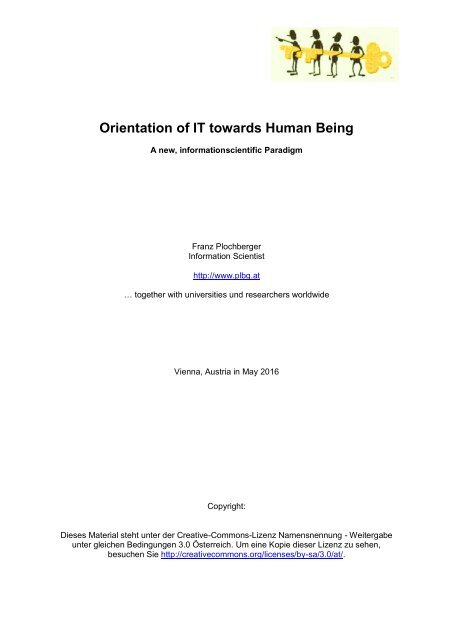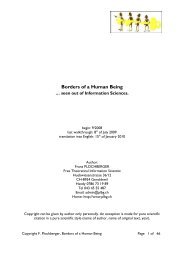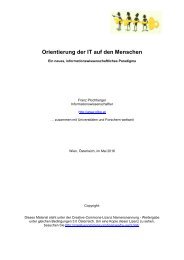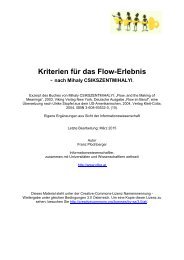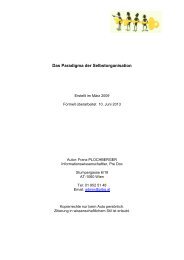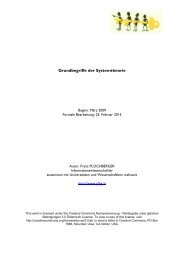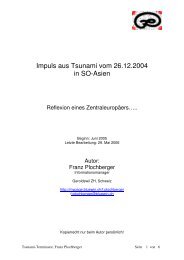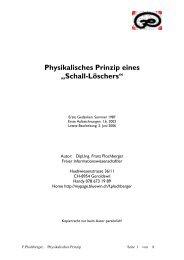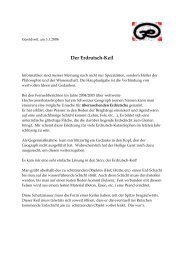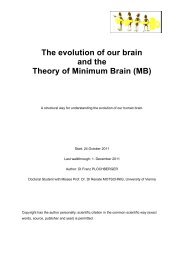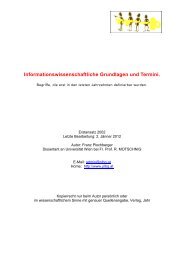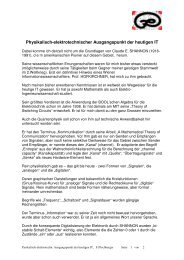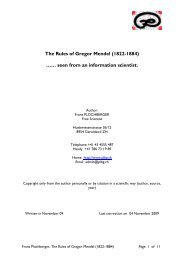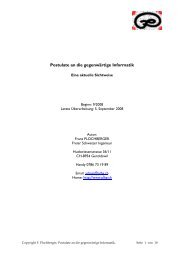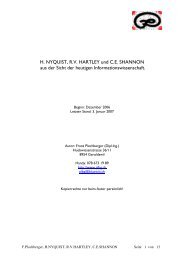Orientation of IT towards Human Being - the Paradigm (2016)
At the beginning of our Age of Information, the 21th century, the influence of IT (Information Technology) got so important that all parts of human live and society where involved. Especially Media Industry started a great hype which is not finished till now. Mobile Media have got a really up to date part of especially young society. On the level of serious science it has been up to date to use the word Information in all reports and publishing papers. A lot of semantics have been used and some scientists (Prof. FLEISSNER, Prof HOFKIRCHNER, Prof. CAPURRO and the author) tried to abstract this word to a constant scientific term. So for first time the author tried a worldwide unifying definition of the terms Information and Data. It’s importance is documented by the topic “Information Scientific Axioms”. In second part – based on it – Clues for generally evidence of Information are written down. They are a set of informationscientific terms - excerpted out of real nature and society. The way of Information between Object and Subject or involving Human Being in big and complex machine systems (aeroplanes, ships and industrial productions) made it necessary to think additionally about the general usage of Information. As a useful result many relationships to other sciences are possible. They bring the benefit to be unifying and scientifically worldwide structuring. As next research object general forms of actual Information are investigated. As final result for future the author asks: „How can we make Information – in all forms – more positive and precious for Human Being? “. This is a new, scientific topic for the future of IT and human society.
At the beginning of our Age of Information, the 21th century, the influence of IT (Information Technology) got so important that all parts of human live and society where involved. Especially Media Industry started a great hype which is not finished till now. Mobile Media have got a really up to date part of especially young society.
On the level of serious science it has been up to date to use the word Information in all reports and publishing papers. A lot of semantics have been used and some scientists (Prof. FLEISSNER, Prof HOFKIRCHNER, Prof. CAPURRO and the author) tried to abstract this word to a constant scientific term. So for first time the author tried a worldwide unifying definition of the terms Information and Data. It’s importance is documented by the topic “Information Scientific Axioms”.
In second part – based on it – Clues for generally evidence of Information are written down. They are a set of informationscientific terms - excerpted out of real nature and society. The way of Information between Object and Subject or involving Human Being in big and complex machine systems (aeroplanes, ships and industrial productions) made it necessary to think additionally about the general usage of Information. As a useful result many relationships to other sciences are possible. They bring the benefit to be unifying and scientifically worldwide structuring.
As next research object general forms of actual Information are investigated.
As final result for future the author asks: „How can we make Information – in all forms – more positive and precious for Human Being? “. This is a new, scientific topic for the future of IT and human society.
Create successful ePaper yourself
Turn your PDF publications into a flip-book with our unique Google optimized e-Paper software.
<strong>Orientation</strong> <strong>of</strong> <strong>IT</strong> <strong>towards</strong> <strong>Human</strong> <strong>Being</strong><br />
A new, informationscientific <strong>Paradigm</strong><br />
Franz Plochberger<br />
Information Scientist<br />
http://www.plbg.at<br />
… toge<strong>the</strong>r with universities und researchers worldwide<br />
Vienna, Austria in May <strong>2016</strong><br />
Copyright:<br />
Dieses Material steht unter der Creative-Commons-Lizenz Namensnennung - Weitergabe<br />
unter gleichen Bedingungen 3.0 Österreich. Um eine Kopie dieser Lizenz zu sehen,<br />
besuchen Sie http://creativecommons.org/licenses/by-sa/3.0/at/.
“Even you see an extremely high mountain before you - for climbing on a<br />
difficult way - you start by o n e step.”<br />
(wisdom)<br />
For my daughters Clara and Isabelle!<br />
©Franz Plochberger, <strong>Orientation</strong> <strong>of</strong> <strong>IT</strong> <strong>towards</strong> <strong>Human</strong> <strong>Being</strong> (<strong>2016</strong>), page 2 <strong>of</strong> 27
1. Abstract<br />
At <strong>the</strong> beginning <strong>of</strong> our Age <strong>of</strong> Information, <strong>the</strong> 21 th century, <strong>the</strong> influence <strong>of</strong> <strong>IT</strong> (Information<br />
Technology) got so important that all parts <strong>of</strong> human live and society where involved.<br />
Especially Media Industry started a great hype which is not finished till now. Mobile Media<br />
have got a really up to date part <strong>of</strong> especially young society.<br />
On <strong>the</strong> level <strong>of</strong> serious science it has been up to date to use <strong>the</strong> word Information in all<br />
reports and publishing papers. A lot <strong>of</strong> semantics have been used and some scientists (Pr<strong>of</strong>.<br />
FLEISSNER, Pr<strong>of</strong> HOFKIRCHNER, Pr<strong>of</strong>. CAPURRO and <strong>the</strong> author) tried to abstract this<br />
word to a constant scientific term. So for first time <strong>the</strong> author tried a worldwide unifying<br />
definition <strong>of</strong> <strong>the</strong> terms Information and Data. It’s importance is documented by <strong>the</strong> topic<br />
“Information Scientific Axioms”.<br />
In second part – based on it – Clues for generally evidence <strong>of</strong> Information are written down.<br />
They are a set <strong>of</strong> informationscientific terms - excerpted out <strong>of</strong> real nature and society. The<br />
way <strong>of</strong> Information between Object and Subject or involving <strong>Human</strong> <strong>Being</strong> in big and<br />
complex machine systems (aeroplanes, ships and industrial productions) made it necessary<br />
to think additionally about <strong>the</strong> general usage <strong>of</strong> Information. As a useful result many<br />
relationships to o<strong>the</strong>r sciences are possible. They bring <strong>the</strong> benefit to be unifying and<br />
scientifically worldwide structuring.<br />
As next research object general forms <strong>of</strong> actual Information are investigated.<br />
As final result for future <strong>the</strong> author asks: „How can we make Information – in all forms – more<br />
positive and precious for <strong>Human</strong> <strong>Being</strong>? “. This is a new, scientific topic for <strong>the</strong> future <strong>of</strong> <strong>IT</strong><br />
and human society.<br />
2. Key Words, Search Items<br />
Information Sciences, Informationscientific Axioms, Information as term, <strong>Orientation</strong> <strong>of</strong> <strong>IT</strong> as<br />
paradigm, Theory <strong>of</strong> Systems, Relation, Relationship, Attachment, Attention, Regard,<br />
Vigilance, Alertness, Awareness, Readiness.<br />
©Franz Plochberger, <strong>Orientation</strong> <strong>of</strong> <strong>IT</strong> <strong>towards</strong> <strong>Human</strong> <strong>Being</strong> (<strong>2016</strong>), page 3 <strong>of</strong> 27
3. Content<br />
1. Abstract ........................................................................................................................... 3<br />
2. Key Words, Search Items ................................................................................................ 3<br />
3. Content ........................................................................................................................... 4<br />
4. Introduction ..................................................................................................................... 5<br />
5. The new findings are compound to a scientific paradigm ................................................ 5<br />
6. „Axioms“ in Information Sciences .................................................................................... 6<br />
6.1. Informationscientific Axiom 1 (IA1) ...............................................................................6<br />
6.2. Informationscientific Axiom 2 (IA2) ...............................................................................6<br />
6.3. Informationscientific Axiom 3 (IA3) ...............................................................................7<br />
7. Informationscientific Postulates (IP) ................................................................................ 8<br />
7.1. IP1: <strong>Human</strong> <strong>Orientation</strong> (HO) <strong>of</strong> <strong>IT</strong> ..............................................................................8<br />
7.2. IP2: Observation <strong>of</strong> Continuity as property ..................................................................8<br />
7.3. IP3: Usage <strong>of</strong> word Information in Science ...................................................................8<br />
8. Discussion <strong>of</strong> Information scientific Axioms and Postulates ............................................. 9<br />
9. Clues in every evidence <strong>of</strong> Information ............................................................................ 9<br />
9.1. Biological and mental State <strong>of</strong> Vigilance, Alertness, Regard or Readiness .................10<br />
9.2. Attention.....................................................................................................................11<br />
9.3. Awareness, Consciousness and Perception ..............................................................12<br />
9.4. Social Relationship and Attachment ...........................................................................13<br />
9.4.1. A Formal Relationship .....................................................................................14<br />
9.4.2. Personal Relationship .....................................................................................14<br />
9.5. Relationship between <strong>Human</strong> <strong>Being</strong> and Machine, Computer or Media (<strong>IT</strong>-Hardware)<br />
………………………………………………………………………………………………15<br />
10. Discussion <strong>of</strong> <strong>the</strong>se Clues ............................................................................................. 16<br />
10.1. Discussion <strong>of</strong> biological and mental State <strong>of</strong> Vigilance, Alertness, Regard or<br />
Readiness .........................................................................................................................16<br />
10.2. Discussion <strong>of</strong> Attention .............................................................................................17<br />
10.3. Discussion <strong>of</strong> Awareness, Consciousness and Perception.......................................17<br />
10.4. Discussion <strong>of</strong> Social Relationship and Attachment ...................................................17<br />
11. General Forms <strong>of</strong> Information Flow ............................................................................... 17<br />
11.1. Genuine, subjective Winning <strong>of</strong> Information .............................................................18<br />
11.2. Subjective Steering, Control and Using <strong>of</strong> <strong>IT</strong>-Applications ........................................18<br />
11.3. Communication ........................................................................................................19<br />
11.4. Cooperation .............................................................................................................20<br />
12. Discussion <strong>of</strong> Forms <strong>of</strong> Information Flow ....................................................................... 21<br />
12.1. Discussion <strong>of</strong> genuine subjective winning <strong>of</strong> Information ..........................................21<br />
12.2. Discussion <strong>of</strong> subjective Steering, Control and Usage <strong>of</strong> <strong>IT</strong>-Applications .................22<br />
12.3. Discussion <strong>of</strong> Communication ..................................................................................22<br />
12.4. Discussion <strong>of</strong> Cooperation .......................................................................................22<br />
13. What makes Information precious? ............................................................................... 23<br />
14. Discussion <strong>of</strong> „What makes Information precious? “ ...................................................... 23<br />
15. Summing Up all as a new paradigm .............................................................................. 24<br />
16. About Author ................................................................................................................. 25<br />
17. Competing Interests ...................................................................................................... 26<br />
18. Literature ....................................................................................................................... 26<br />
©Franz Plochberger, <strong>Orientation</strong> <strong>of</strong> <strong>IT</strong> <strong>towards</strong> <strong>Human</strong> <strong>Being</strong> (<strong>2016</strong>), page 4 <strong>of</strong> 27
4. Introduction<br />
A supposed “over streng<strong>the</strong>ning” <strong>of</strong> public health in common world <strong>of</strong> work and society is one<br />
main reason for this research paper. It’s not exactly pro<strong>of</strong>able that Informatics is a source <strong>of</strong><br />
such a negative effect, but Information Sciences try to find clues to manage <strong>the</strong> actual <strong>IT</strong><br />
(Information Technology) as a positive fact <strong>of</strong> our society, because <strong>IT</strong> got inevitably a new<br />
real fact <strong>of</strong> our actual and future human life.<br />
Information Science doesn’t want to give a single pragmatic concept for healing. That‘s <strong>the</strong><br />
area <strong>of</strong> a new created pr<strong>of</strong>ession: Ergonom or Specialist in Occupational Physician. Existing<br />
diseases in organic or psychical way - caused by wrong usage <strong>of</strong> <strong>IT</strong> in <strong>of</strong>fice and private -<br />
can already be prevented or even healed by <strong>the</strong>m.<br />
In this paper some clues (in scientific form) are given. Beneficiaries <strong>of</strong> <strong>the</strong>se researches are<br />
<strong>the</strong> purchaser, developer and user <strong>of</strong> <strong>IT</strong> systems and media. Bridges to Psychology and<br />
Sociology can be made easier. A welcomed method – but here not used - is to make<br />
interviews with all involved groups <strong>of</strong> people. Many existing results are already useful and<br />
very remarkable.<br />
A new question is asked: How can we organise <strong>IT</strong> and Media Technology b y t h e i r o w n<br />
or i n t h e i r k e r n e l – to prevent mental or biological damage <strong>of</strong> <strong>Human</strong> <strong>Being</strong>s? Is this<br />
possible? The developed paradigm tries to be a general impact for future research and<br />
awareness.<br />
The found terms are not new; <strong>the</strong>y all exist already but were in danger to get lost, forgotten<br />
or ignored. The terms Data, Information could be defined in <strong>the</strong> last years nearly unifying for<br />
all sciences. Theoretical Physics seam to keep <strong>the</strong>ir special ma<strong>the</strong>matically definitions (since<br />
SHANNON) – <strong>the</strong>y are here used as special defining <strong>of</strong> Data.<br />
The new science <strong>of</strong> Information (= Information Sciences) gets useful. The indispensable<br />
involvement <strong>of</strong> <strong>the</strong> <strong>Human</strong> <strong>Being</strong> in <strong>IT</strong> has to be condignly highlighted. This science was for<br />
first time defined already in 1968 (BORKO H. (1968)). A networking <strong>of</strong> informationscientific<br />
results can be useful in a rich amount. Beside Ma<strong>the</strong>matics, Physics, Informatics additionally<br />
<strong>the</strong> sciences Psychology, Sociology, Communication Sciences, Systems Theory and<br />
Philosophy can be involved.<br />
5. The new findings are compound to a scientific paradigm<br />
The paradigm „<strong>Orientation</strong> <strong>of</strong> <strong>IT</strong> <strong>towards</strong> <strong>Human</strong> <strong>Being</strong>“ can be shown in 4 great elements:<br />
The Axioms in Information Sciences are an empirically found, fundamental<br />
and general entry to Information Sciences.<br />
Selective Clues for each Information Event are a unified and direct entry to<br />
every Information.<br />
Common Forms <strong>of</strong> Information Flows are a usable overview.<br />
Finally <strong>the</strong> question is asked: How gets Information always positive and<br />
precious for <strong>Human</strong> <strong>Being</strong>?<br />
©Franz Plochberger, <strong>Orientation</strong> <strong>of</strong> <strong>IT</strong> <strong>towards</strong> <strong>Human</strong> <strong>Being</strong> (<strong>2016</strong>), page 5 <strong>of</strong> 27
6. „Axioms“ in Information Sciences<br />
These thoughts lead bottom up from praxis in <strong>IT</strong> to genuine <strong>the</strong>ory (Philosophy, Information<br />
Sciences) for coming decades. The mental cut-set is scientifically founded, even historically.<br />
The defined term Axiom is nature scientifically, factually founded. Information Technology<br />
(<strong>IT</strong>) by itself is <strong>the</strong> source.<br />
A philosophically-logically pro<strong>of</strong> <strong>of</strong> <strong>the</strong>se single axioms among <strong>the</strong>mselves is not necessary.<br />
They are single, “true assertions“. Their contents are in our Age <strong>of</strong> Information - using <strong>the</strong><br />
words Information, Data, Subject and Object in very manifold ways – a welcomed structuring<br />
and unifying <strong>of</strong> scientific terms. They are in <strong>the</strong>ir form new but not surprising.<br />
6.1. Informationscientific Axiom 1 (IA1)<br />
.<br />
Data describe an Object<br />
All Data in common are divided in only two groups:<br />
a) stored, materially existing, „dead“ Data<br />
b) „living“ Data, in living data carriers = Organisms.<br />
Only one subset between a) and b) can be defined: <strong>the</strong> „1:1-Data“, named also as „Data not<br />
distinguishable from nature“ or „documentations <strong>of</strong> reality” (f. i. documentary films,<br />
nature films, original voice storages and videos).<br />
More differentiated structuring does not make sense on this level. It would be too complex<br />
because all Data <strong>of</strong> all existing <strong>IT</strong> applications or Objects in our time can`t be organized in<br />
one unifying way.<br />
Acknowledgement: Data <strong>the</strong>mselves can be seen as Objects <strong>of</strong> our perception (f. i.<br />
documentations). That makes sense if no Object is existing - only Data about a fact.<br />
6.2. Informationscientific Axiom 2 (IA2)<br />
Information is that content <strong>of</strong> an Object which is interesting for a<br />
<strong>Human</strong> <strong>Being</strong>.<br />
This term „Information“ can be used by this for first time unified – historically and actually.<br />
The relationship Information-<strong>Human</strong> <strong>Being</strong> is logically definable in form <strong>of</strong> an Indirect<br />
Conclusion:<br />
©Franz Plochberger, <strong>Orientation</strong> <strong>of</strong> <strong>IT</strong> <strong>towards</strong> <strong>Human</strong> <strong>Being</strong> (<strong>2016</strong>), page 6 <strong>of</strong> 27
If a <strong>Human</strong> <strong>Being</strong> is not existent or involved n o Information is created.<br />
<strong>Human</strong> <strong>Being</strong> is in this connection a synonym or every living Subject – reduced to his special<br />
evolutional level.<br />
Information is so only that what a <strong>Human</strong> <strong>Being</strong> can recognize by his senses, what he can<br />
think about and what he can send to his surrounding in any way. Information doesn´t have to<br />
be defined exactly detailed; it is an existing „something“, which is consciously recognized by<br />
a <strong>Human</strong> <strong>Being</strong>.<br />
First scientific result: Data and Information are exact distinguishable.<br />
6.3. Informationscientific Axiom 3 (IA3)<br />
The value <strong>of</strong> Data is defined by <strong>the</strong> Information included in <strong>the</strong>m.<br />
Acknowledgement: Objects alone can be Data too (f. i. if only Objects and not yet Data are<br />
existent).<br />
Great advantage <strong>of</strong> all three axioms is <strong>the</strong>ir generally usability in all sciences – even in<br />
Physics. SHANNON’s Theory <strong>of</strong> Information gets so to a special ma<strong>the</strong>matically formula for<br />
„binary Data enumbering“.<br />
For more background read PLOCHBERGER Franz (2013).<br />
©Franz Plochberger, <strong>Orientation</strong> <strong>of</strong> <strong>IT</strong> <strong>towards</strong> <strong>Human</strong> <strong>Being</strong> (<strong>2016</strong>), page 7 <strong>of</strong> 27
Out <strong>of</strong> all <strong>the</strong>se three axioms follow immediately<br />
7. Informationscientific Postulates (IP)<br />
7.1. IP1: <strong>Human</strong> <strong>Orientation</strong> (HO) <strong>of</strong> <strong>IT</strong><br />
Is a direct sequence to IA2 (necessary relationship to <strong>Human</strong> <strong>Being</strong>). User Centred Design<br />
(UCD), ISO 9241, <strong>Human</strong> Computer Interaction (HCI), Ergonomy et al. are existing terms in<br />
actual <strong>IT</strong>, but I think <strong>the</strong>y are not enough general and targeted. <strong>Human</strong> mind and soul had<br />
been “conquered = influenced” by <strong>IT</strong>. We need <strong>the</strong>refore a paradigm change in <strong>IT</strong>. The little<br />
steps coming from market are too small. The <strong>Human</strong> <strong>Being</strong> in his cognition-evolutional,<br />
biological borders has to be centred consciously, - Information scientifically - as most active<br />
and living agent and as consciously deciding and creative part in <strong>IT</strong>. This postulate led<br />
intuitive to a wider paradigm as showed in this script.<br />
7.2. IP2: Observation <strong>of</strong> Continuity as property<br />
It comes from human Organisation (in <strong>the</strong> usage <strong>of</strong> C. MATURANA) and from human way <strong>of</strong><br />
agitation. <strong>Human</strong> nervous systems and blood circuits - as most important carriers <strong>of</strong> „living<br />
Data“ in human organism - are genuine continual. They are flowing life. This property is<br />
actually totally missing in Information Sciences, f. i.:<br />
<br />
<br />
<br />
at incompatible changes <strong>of</strong> Hard- and S<strong>of</strong>tware: an additional, great economic<br />
expenditure is necessary and rare raw materials are wasted; sometimes even<br />
consciously planned obsolescence is done or<br />
at long termed storage <strong>of</strong> electronically Data: general uncoordinated, technologically<br />
new equipments are necessary; <strong>the</strong>y are extensive and incontinuous too or<br />
at sociological changes in working world: <strong>the</strong>y get more important by wrong usage <strong>of</strong><br />
<strong>IT</strong>. A bad consequence is that unemployment and growing difference between poor<br />
and rich are existing facts <strong>of</strong> our high technological industrial society. No sociological<br />
counteractions are started yet - even as <strong>the</strong>y are easier possible than before <strong>IT</strong>.<br />
7.3. IP3: Usage <strong>of</strong> word Information in Science<br />
Information by itself is „only something new“. The word is not new. But its usage is a sign that<br />
something new and unnamed has been found. Using <strong>the</strong> word Information in scientific<br />
connection activates:<br />
<br />
<br />
more exactly, new definitions <strong>of</strong> every new found situation and<br />
finally a new differentiated scientific term for every new found fact.<br />
A conscious new contribution arises and a deeper mental reasoning can be activated.<br />
O<strong>the</strong>rwise <strong>the</strong> new found fact will be forgotten again in short time or ano<strong>the</strong>r verbal, not yet<br />
scientifically exact description will remain as open problem.<br />
©Franz Plochberger, <strong>Orientation</strong> <strong>of</strong> <strong>IT</strong> <strong>towards</strong> <strong>Human</strong> <strong>Being</strong> (<strong>2016</strong>), page 8 <strong>of</strong> 27
8. Discussion <strong>of</strong> Information scientific Axioms and Postulates<br />
The real value <strong>of</strong> <strong>the</strong>se „Informationscientific Axioms“ can’t be evaluated high enough. The<br />
first impression is that <strong>the</strong>y are simple but <strong>the</strong> importance in whole science is great. We are<br />
used to complex systems in nature science. These axioms are fundamental and not complex<br />
but unifying in most known sciences.<br />
Information and Data get clearly differentiable as <strong>the</strong>y appear in real nature. Information as<br />
known term since time <strong>of</strong> Romans exists continuously in our time too.<br />
SHANNON’s Theory <strong>of</strong> Information is sufficiently pointed out as too narrow. It’s a set <strong>of</strong><br />
genuine ma<strong>the</strong>matical formulas in <strong>the</strong> <strong>the</strong>ories <strong>of</strong> transmitting <strong>of</strong> electronically signals (which<br />
can now be pointed out as Data).<br />
The indispensable relationship <strong>Human</strong> <strong>Being</strong> - Information (IA2) is a kernel <strong>of</strong> <strong>the</strong>se axioms.<br />
The term axiom is justified by nature scientific evidence in our life today. No pro<strong>of</strong> is<br />
necessary - only acceptance <strong>of</strong> facts.<br />
One group <strong>of</strong> Data – <strong>the</strong> living Data – got very extracted but helpful term for understanding<br />
Neuro Sciences. Here Data carrier and <strong>Human</strong> <strong>Being</strong> is <strong>the</strong> same. IA2 from above has no<br />
importance for defining <strong>the</strong> term Information. The differentiation between (living) Data and<br />
Information can be made by <strong>the</strong> critical but separating term Consciousness (see following<br />
later on). Real Information needs human Consciousness o<strong>the</strong>rwise we speak <strong>of</strong> living Data.<br />
Latest research <strong>of</strong> <strong>the</strong> human brain - Neuro-Biology - can decide clearly between<br />
Consciousness and Unconsciousness. Living Data in our brain are <strong>the</strong> biological basis. The<br />
mental moment <strong>of</strong> first evidence <strong>of</strong> Consciousness is not definable so exactly – it’s a genuine<br />
human-mental procedure. So getting Consciousness as human feeling is connected to<br />
getting internal Information about something new sensually recognised.<br />
The postulates - following <strong>the</strong> axioms - are some general first examples for using <strong>the</strong>se<br />
axioms. We will use <strong>the</strong> word Information in future too, but if we use it in scientifically<br />
connections we should be stimulated to define “that new-found-something” more exactly.<br />
The terms Information or Data are no terms about <strong>the</strong>ir content or semantic. These are too<br />
manifold in <strong>the</strong>ir structure and not definable in a sufficient unified way.<br />
But what seems important in future is <strong>the</strong> term “value” (<strong>of</strong> Data or Information).<br />
9. Clues in every evidence <strong>of</strong> Information<br />
They are genuine empirically found and are control points or topics. The used cognitive<br />
method by generating new terms is well known especially in Informatics and useful in every<br />
new and complex area.<br />
Every procedure, flow or evidence <strong>of</strong> Information is happening between Subject(s) und<br />
Object(s). Subject and Object as terms where used already in classical, antique philosophy.<br />
An Object is any item or matter which is recognized by a Subject. An expanding variation is<br />
<strong>the</strong> possibly <strong>of</strong> permanently, spatial inversion <strong>of</strong> <strong>the</strong> direction <strong>of</strong> Information. Therefore a<br />
©Franz Plochberger, <strong>Orientation</strong> <strong>of</strong> <strong>IT</strong> <strong>towards</strong> <strong>Human</strong> <strong>Being</strong> (<strong>2016</strong>), page 9 <strong>of</strong> 27
Subject is directed to one or more Objects (1:n relation) and an Object can be directed to one<br />
or more Subjects (n:1 relation). These relations can be direct or indirect about stored Data.<br />
Paul WATZLAWICK (1921-2007), an Austrian-American Communication Scientist,<br />
Psycho<strong>the</strong>rapist, Sociologist and Philosopher said: „No (living) <strong>Human</strong> <strong>Being</strong> is able to<br />
communicate not“. Used in our Information procedure: The (living) <strong>Human</strong> <strong>Being</strong> is<br />
permanently part <strong>of</strong> any procedure with flow <strong>of</strong> Information.<br />
These clues in an Information event are<br />
<br />
<br />
<br />
<br />
<br />
biological and mental state <strong>of</strong> Vigilance, Alertness, Regard or Readiness,<br />
Attention,<br />
Consciousness, Awareness, Perception,<br />
social relationship and Attachment,<br />
special relationship between <strong>Human</strong> <strong>Being</strong> and <strong>IT</strong>-Hardware.<br />
9.1. Biological and mental State <strong>of</strong> Vigilance, Alertness, Regard or<br />
Readiness<br />
We need first vitality as basic biological state. It’s banal, but genuine Information can be got<br />
or given scientifically only by a living <strong>Human</strong> <strong>Being</strong> (or an evolutionally reduced form <strong>of</strong> any<br />
living organism). A dead <strong>Human</strong> <strong>Being</strong> is a common dead Object only in a special shape,<br />
with defined features and properties and can’t accept or treat Information. Simple example:<br />
only a living animal is able to recognise f. i. a dead one. Or: A unknown, never found, human<br />
corpse is so long no source <strong>of</strong> Information, because nobody (no living entity) has this<br />
Information – <strong>of</strong> course this change is if someone finds that copse.<br />
Out <strong>of</strong> Philosophy well known terms can be related here: <strong>the</strong> <strong>Being</strong> (first time found by<br />
ARISTOTELES) or <strong>the</strong> Existence <strong>of</strong> a living <strong>Human</strong> <strong>Being</strong>.<br />
The biological vigilance or alertness <strong>of</strong> a human being is a next step. A sleeping <strong>Human</strong><br />
<strong>Being</strong> f. i. is reduced in his ability to treat Information; his body and mind is in a biologically<br />
resting, refreshing state.<br />
O<strong>the</strong>rs, higher and a little bit more active human states are human wakefulness or mental<br />
openness.<br />
Mental readiness and mental ability are o<strong>the</strong>r general human states. <strong>Human</strong> existence is<br />
signified by a permanent, biologic-sensual and mental activity – <strong>the</strong> human brain and <strong>the</strong><br />
human nervous system transport permanently electro-chemical signals and biological<br />
messages tour brain and make it decidable.<br />
Details are consciously not worked out in this paradigm; <strong>the</strong>y are already wide areas in<br />
Neuro Sciences, Psychology or Sociology.<br />
That’s informationscientifically enough for our paradigm. A deeper differentiation would go<br />
beyond <strong>the</strong> scope and poise <strong>the</strong> goal.<br />
©Franz Plochberger, <strong>Orientation</strong> <strong>of</strong> <strong>IT</strong> <strong>towards</strong> <strong>Human</strong> <strong>Being</strong> (<strong>2016</strong>), page 10 <strong>of</strong> 27
9.2. Attention<br />
A single transport <strong>of</strong> Information starts by an impact from outside or from inside <strong>the</strong> human<br />
being. The first appearance <strong>of</strong> an event<br />
<br />
<br />
from outside our brain and his recognition by a human sense or<br />
internal in our brain - every thought, mental activity or will<br />
is named Attention.<br />
Not every Attention to a physical object or mental thought evaluates to a conscious,<br />
biological result as a biological move-action or conscious report. Attention is certainly an<br />
evidence <strong>of</strong> “living data transport” in our nerves between our senses and brain. It starts<br />
mostly unconsciously and can be changed unconsciously by ano<strong>the</strong>r, more interesting object<br />
or thought. It can get consciously by time. It can start consciously in some cases immediately<br />
(top-down, voluntarily).<br />
A scientifically deeper going work about <strong>the</strong>se brain-biologically facts can be read in CHUN,<br />
GOLOMB, TURK-BROWNE (2011). On p 77 ff he makes a fine difference between External<br />
and Internal Attention – similar to <strong>the</strong> terms Attention in- or outside <strong>of</strong> our brain.<br />
In ano<strong>the</strong>r publication similar differentiation can be found: PINTO Yair, VAN DER LEIJ<br />
Andries R, SLIGTE Ilja G., LAMME Victor A. F., SCHOLTE H. Steven (2013).<br />
So some o<strong>the</strong>r possible, synonym adjectives for Attention are used:<br />
<br />
<br />
inside our brain or internal, endogenous, voluntarily, stimulus driven or topdown<br />
and<br />
outside our brain or external, exogenous, salient stimuli, goal oriented or<br />
goal directed, (spatial or conspicuously featured) or bottom-up.<br />
Both groups are significant and <strong>the</strong>refore remarkable. In PINTO Yair, VAN DER LEIJ<br />
Andries R, SLIGTE Ilja G., LAMME Victor A. F., SCHOLTE H. Steven (2013), p10 we can<br />
read about Dutch research results : “Tests <strong>of</strong> a large and representative sample <strong>of</strong> <strong>the</strong> Dutch<br />
population provide strong evidence that two types <strong>of</strong> attention, bottom-up and top-down<br />
attention, are uncorrelated. This suggests that <strong>the</strong>re are two independent attentional systems<br />
controlling <strong>the</strong>se types <strong>of</strong> attention. We speculate that bottom-up capture is not contingent on<br />
top-down settings, and that bottom-up attention and top-down attention are differentially<br />
linked to consciousness“.<br />
The following procedure to <strong>the</strong>se different starting-types <strong>of</strong> attention is common to both. In<br />
both cases <strong>the</strong> brain acts in <strong>the</strong> same way - here we can say “living data transport” is <strong>the</strong><br />
biological background.<br />
The combined state to Attention, <strong>the</strong> “result” <strong>of</strong> Attention is a fix decided selection <strong>of</strong> an<br />
object by all our senses. A once done selection can even be changed immediately and this<br />
can be done consciously or unconsciously.<br />
Now <strong>the</strong> question is open: When is this selection conscious or unconscious? LAMME V.A.F.<br />
(2004) published his answer to this question. He and o<strong>the</strong>rs give a view into actual human<br />
brain research and can show fine brain-biological facts differentiating clear <strong>the</strong> terms<br />
Attention and Awareness or Consciousness.<br />
©Franz Plochberger, <strong>Orientation</strong> <strong>of</strong> <strong>IT</strong> <strong>towards</strong> <strong>Human</strong> <strong>Being</strong> (<strong>2016</strong>), page 11 <strong>of</strong> 27
9.3. Awareness, Consciousness and Perception<br />
LAMME V.A.F. (2004), p 870 could point out some neuro-scientific states in case <strong>of</strong> visual<br />
perception:<br />
a.) up to 40ms: a visual input is given to eyes,<br />
b.) between 60-80 ms: this input creates a fed forward (neural excitation) from eyes to<br />
brain; this happens unconsciously to <strong>Human</strong> <strong>Being</strong>,<br />
c.) between 100-150 ms: <strong>the</strong> fed forward reaches <strong>the</strong> proper extrastriate area in <strong>the</strong><br />
brain (= visual area) and starts a recurrent interaction to eye and o<strong>the</strong>r regions<br />
(memory, motoric area, area for reasoning); when more than one stimuli are excited<br />
<strong>the</strong> whole neural net gets into <strong>the</strong> state <strong>of</strong> “phenomenal awareness” <strong>of</strong> all; to one<br />
stimulus possibly an unconscious response can be given,<br />
d.) between 200-300 ms: all neurons between one selected stimulus and <strong>the</strong> visual<br />
area in <strong>the</strong> brain are engaged in higher and synchronic, recurrent interactions;<br />
that one Object reaches <strong>the</strong> state <strong>of</strong> “access awareness”; a conscious response<br />
can be given to <strong>the</strong> selected object; all stimuli toge<strong>the</strong>r remain in <strong>the</strong> state <strong>of</strong><br />
“phenomenal awareness”<br />
e.) afterwards <strong>the</strong> selected stimulus is stored into Working Memory; o<strong>the</strong>r stimuli are<br />
stored in Retinotopic Iconic Memory (Sensoric Memory)<br />
According to <strong>the</strong>se precious, scientific results we can give clear differentiations <strong>of</strong> <strong>the</strong> terms<br />
Attention, Awareness, Consciousness and Perception. This way <strong>of</strong> thinking is very welcome<br />
in Informatics and Information Sciences:<br />
Attention is <strong>the</strong> neuronal state <strong>of</strong> excitation by one or more objects from first evidence up to<br />
<strong>the</strong> moment <strong>of</strong> selection. By selection <strong>the</strong> Attention is finished. Attention can be unconscious<br />
or conscious.<br />
Awareness is divided by LAMME into<br />
phenomenal awareness: that’s an unconscious “sensing” <strong>of</strong> our neuronal net; it<br />
senses different happenings <strong>of</strong> stimuli for our senses and<br />
<br />
access awareness: is <strong>the</strong> name <strong>of</strong> <strong>the</strong> state after deciding, which stimulus has been<br />
selected and to witch stimulus recurrent interactions are started.<br />
Consciousness is starting by LAMME at <strong>the</strong> neuronal starting <strong>of</strong> recurrent interactions<br />
between brain areas and sensoric organs. Besides this neuronal definition he differentiates<br />
a mental consciousness. It’s remarkable that he separates this genuine human, mental state.<br />
Perception is in my point <strong>of</strong> view <strong>the</strong> mental recognition, reasoning and storing in Long Time<br />
Memory <strong>of</strong> any fact <strong>of</strong> our surrounding.<br />
For this paradigm only that real connections and thoughts are valid which evaluate to a<br />
conscious flow <strong>of</strong> Information. In <strong>the</strong> axioms above Information is defined as conscious<br />
reaction <strong>of</strong> a Subject (<strong>Human</strong> <strong>Being</strong>) to an Object. All unconscious reactions or impulsions<br />
can be categorised in IS (Information Sciences) as biological or living Data transport<br />
(PLOCHBERGER Franz (2011), p 9). This differentiation makes IS very useful.<br />
©Franz Plochberger, <strong>Orientation</strong> <strong>of</strong> <strong>IT</strong> <strong>towards</strong> <strong>Human</strong> <strong>Being</strong> (<strong>2016</strong>), page 12 <strong>of</strong> 27
It’s not recommended in IS to call an evidence <strong>of</strong> Information a “process”. This term is too<br />
technically or juristically. In IS it’s better to use <strong>the</strong> words: procedure, event, evidence, flow or<br />
like LAMME – an interaction. So <strong>the</strong> living, biological background is better signified.<br />
At all <strong>the</strong>se flows <strong>of</strong> Information <strong>the</strong> <strong>Human</strong> <strong>Being</strong> has to be seen as one whole entity<br />
consisting <strong>of</strong> body and mind, with all his perceptions by all his senses and abilities – or as<br />
we say in positive Psychology by his whole soul. That’s important later following parts <strong>of</strong><br />
this paradigm.<br />
9.4. Social Relationship and Attachment<br />
The flow <strong>of</strong> Information can be divided between more than one sender and receiver. In that<br />
case <strong>the</strong> intensity or amount <strong>of</strong> Information is split too. Mihály CSIKSZENTMIHALYI (born<br />
1934 in Rijeka, Croatia, living in USA), a well known positivistic Psychologist <strong>of</strong> our time,<br />
could point out, that <strong>the</strong> human being is able to communicate in best way with o n e human<br />
dialog partner – maximal with t w o (CSIKSZENTMIHALYI Mihaly (2004), second half).<br />
In IS (Information Sciences) we can take <strong>the</strong> word “relation” from classical Ma<strong>the</strong>matics<br />
where it’s token from Latin “relatio”: genuine topologically 2 or more points in a plane or in a<br />
room can have a relation between each o<strong>the</strong>r. This relation exists or doesn’t exist.<br />
Here a relation or relationship can be seen as sensually, cognisable connection between<br />
Subjects or between Subjects and Objects.<br />
Information can’t exist without <strong>Human</strong> <strong>Being</strong>. In Psychology, Sociology, Communication<br />
Sciences or Economy <strong>the</strong> term relationship is well known and has an important, fundamental<br />
meaning. That may be sinful in Information Sciences too.<br />
It’s realistic in IS to differentiate this term a little bit more in<br />
<br />
<br />
social relationship between <strong>Human</strong> <strong>Being</strong>s and<br />
relationship between <strong>Human</strong> <strong>Being</strong> and machines, computers or media (see<br />
next chapter).<br />
In Sociology (f. i. DÖRING Nicola (2003), p 405) and Psychology (f. i. TRIMMEL Michael<br />
(2003), p 93-96) <strong>the</strong>se social relationships – between Subjects – are treated extensively and<br />
detailed. This is done in an interesting way in both sciences nearly in <strong>the</strong> same meaning.<br />
Social Relationships (between Subjects) can be differentiated by <strong>the</strong>ir function into<br />
<br />
<br />
formal (factual) and<br />
personal relationships<br />
and both again by <strong>the</strong>ir subjective meaning in<br />
<br />
<br />
relationships with strong (narrow) attachments and<br />
relationships with weak (loose) attachments.<br />
©Franz Plochberger, <strong>Orientation</strong> <strong>of</strong> <strong>IT</strong> <strong>towards</strong> <strong>Human</strong> <strong>Being</strong> (<strong>2016</strong>), page 13 <strong>of</strong> 27
9.4.1. A Formal Relationship<br />
exists between Subjects which are involved in Systems <strong>of</strong> Functions. These single Subjects<br />
have in <strong>the</strong>mselves preset duties and roles and are supposed under one main goal (f. i.<br />
political agitation <strong>of</strong> opinions, economical pr<strong>of</strong>it or public administration). All involved<br />
Subjects are organised in a preset hierarchy. Personal Relationships (f. i. Sympathy or<br />
antipathy) are consciously reduced; in Formal Relationships transport <strong>of</strong> Data, goods and<br />
orders is important.<br />
Depending on duration and mental depth <strong>of</strong> a formal relationship <strong>the</strong>y can have<br />
<br />
<br />
Weak (Loose) Attachment: f. i. customers, colleagues at work, political party<br />
members, state residents or<br />
Strong (Narrow) Attachment: f. i. experienced working colleagues,<br />
committed political party members, active state residents, regular customers<br />
or physician-patient-relationships<br />
9.4.2. Personal Relationship<br />
Attachment - a mentally deeper going term – gets now important. It includes an additional<br />
feeling and emotional meaning. It can be genuine psychologically - in a single <strong>Human</strong> <strong>Being</strong><br />
or socially - between <strong>Human</strong> <strong>Being</strong>s. Variations can be<br />
<br />
<br />
<br />
<br />
<br />
genuine on <strong>the</strong> surface,<br />
for a short time,<br />
can go deeper into consciousness,<br />
can exist for a long time or<br />
can even stay for whole lifetime.<br />
In <strong>the</strong>se Attachments formal roles and clichés are hindering. The Relationship gets more<br />
free, manifold and first <strong>of</strong> all more human. Counting values are: sympathy, antipathy, trusting.<br />
The Relationship by itself is cultivated.<br />
In mental depth we differentiate here too between<br />
Weak (Loose) Attachment<br />
f. i. neighbours, loose contacts and<br />
Strong (Narrow) Attachment<br />
f. i. a parent-child Attachment, a personal friendship or a long termed love<br />
Attachment.<br />
©Franz Plochberger, <strong>Orientation</strong> <strong>of</strong> <strong>IT</strong> <strong>towards</strong> <strong>Human</strong> <strong>Being</strong> (<strong>2016</strong>), page 14 <strong>of</strong> 27
9.5. Relationship between <strong>Human</strong> <strong>Being</strong> and Machine, Computer or<br />
Media (<strong>IT</strong>-Hardware)<br />
This Relationship has been researched since beginning <strong>of</strong> Information Technology (<strong>IT</strong>) in<br />
about 1950 by SHANNON, ZUSE, VON NEUMANN or since beginning <strong>of</strong> IS by finding <strong>of</strong><br />
worldwide Internet in 1989 (Tim BERNERS-LEE).<br />
It’s roots can be found in beginning <strong>of</strong> US-American industrialisation <strong>of</strong> human-machineworking<br />
processes. Frederick Winslow TAYLOR (1856-1915) started to research this<br />
working area systematically. The result is named to him as „Taylorism“.<br />
On one step fur<strong>the</strong>r, during <strong>the</strong> 1 st World War, in US-America research <strong>of</strong> working processes<br />
went on. Especially <strong>the</strong> relationships between solders and (weapon-) systems (<strong>Human</strong> <strong>Being</strong><br />
- machine relationship) was started to be researched scientifically. The term „<strong>Human</strong> Factor“<br />
(HF) was created. Some medicals and bachelors tried to find new ma<strong>the</strong>matical and<br />
systematically rules. The knowledge <strong>of</strong> engineers building aeroplanes or boats was<br />
combined with knowledge <strong>of</strong> Psychology (f. i. amount <strong>of</strong> errors, necessity and organisation <strong>of</strong><br />
pr<strong>of</strong>essional trainings). See in: MEISTER David (1999).<br />
This way <strong>of</strong> thinking was continuated after 2nd World War in western nations: England,<br />
France, Germany and last not least with political attributes in Sowjet Union. They started a<br />
continuation in civil working world. So a new science was created: Ergonomy or<br />
Occupational Medicine. Today even a new pr<strong>of</strong>ession is created: Ergonom or Occupational<br />
Physician (a combination <strong>of</strong> engineer and physician “medicus”). In most universities this<br />
knowledge is taught today.<br />
This present paradigm is a continuation <strong>of</strong> <strong>the</strong>se researches in IS and <strong>IT</strong>. So a new general<br />
and scientific way into development <strong>of</strong> future <strong>IT</strong> and media should be found. The <strong>Orientation</strong><br />
<strong>towards</strong> <strong>Human</strong> <strong>Being</strong> is necessary because <strong>the</strong> <strong>Human</strong> <strong>Being</strong> in his whole biological<br />
evolution has a very slow change time. On <strong>the</strong> o<strong>the</strong>r side <strong>the</strong> technologically cognitive<br />
evolution is very fast and gets manifold more and more – with no end.<br />
Every relationship between <strong>Human</strong> <strong>Being</strong> and machine can be seen as relationship between<br />
<strong>Human</strong> <strong>Being</strong> and a user-screen. Nearly all complex machines have on her user-surface an<br />
electronically user-display.<br />
The involvement Attachment in IS is till now not yet researched exactly. It appeared not yet in<br />
MCI (Machine Computer Interface) - or UCD (User Centred Design) – research. It’s used<br />
here for first time in IS.<br />
The relationship between <strong>Human</strong> <strong>Being</strong> and machine and especially <strong>Human</strong> <strong>Being</strong> and<br />
computer and media is definable as formal relationship (orientated to a goal or purpose,<br />
given by a special <strong>Human</strong> <strong>Being</strong> – <strong>the</strong> owner <strong>of</strong> a system).<br />
The created System is a System <strong>of</strong> Functions. Every Function has its predefined duty. All<br />
Functions serve to a Main Goal which was preset by <strong>the</strong> Owner or Purchaser <strong>of</strong> a system (f.<br />
i. state, bank or trading <strong>of</strong>fice). It can be<br />
<br />
<br />
closed: Subject uses a programmed and tested <strong>IT</strong>-Application,<br />
open: Subject uses WWW or a Social Network (Facebook, Twitter).<br />
©Franz Plochberger, <strong>Orientation</strong> <strong>of</strong> <strong>IT</strong> <strong>towards</strong> <strong>Human</strong> <strong>Being</strong> (<strong>2016</strong>), page 15 <strong>of</strong> 27
The Attachment <strong>of</strong> a living Subject (<strong>Human</strong> <strong>Being</strong>) is bordered by human biologically and<br />
mentally senses. Treatment <strong>of</strong> <strong>the</strong>m can get singularly to heavy. That can create addictive<br />
behavior (DÖRING Nicola (2003), p 304 ff). These and o<strong>the</strong>r dangers should be prohibited<br />
by <strong>IT</strong> and Media. Till now we have no solutions. Only commercial factors control <strong>the</strong> design<br />
<strong>of</strong> new developments. Developed will be what can be sold.<br />
We have to see <strong>the</strong> <strong>Human</strong> <strong>Being</strong> generally (= biologically and mentally)<br />
<br />
<br />
on one side as real creator and user <strong>of</strong> <strong>IT</strong> and<br />
on <strong>the</strong> o<strong>the</strong>r side as border <strong>of</strong> <strong>IT</strong> and Media.<br />
Into direction <strong>of</strong> <strong>IT</strong> and Media – into physical technologies – no borders can be seen in<br />
future.<br />
In <strong>the</strong> o<strong>the</strong>r possible direction – into <strong>Human</strong> <strong>Being</strong> – here in a selective and conscious way<br />
has been started. There are biologically and mental borders and necessities. That’s fixing till<br />
now.<br />
10. Discussion <strong>of</strong> <strong>the</strong>se Clues<br />
Using <strong>the</strong>se clues shows that <strong>the</strong> material <strong>of</strong> research is very wide and complex. The<br />
extraction <strong>of</strong> clues is per se one <strong>of</strong> many possible ways <strong>of</strong> research.<br />
Different ways <strong>of</strong> thinking between Information Sciences, Informatics and Neuro Sciences,<br />
Psychology or Biology get involved by this style.<br />
In Information Sciences – including Informatics - conceptional methods are desired and will<br />
be developed. Clear structured systems with well defined relations and terms are <strong>the</strong> goal.<br />
The result is a new created or artificial concept.<br />
In Neuro Sciences, Psychology or Biology we have a complex, pre-given biologically<br />
organism – <strong>the</strong> <strong>Human</strong> <strong>Being</strong>. We only can try to describe him or she. So <strong>the</strong> result is not so<br />
clear structured but manifold and complex – as nature <strong>of</strong> organism and human brain is. We<br />
can find empirically some characteristic facts and <strong>the</strong>ir conditions for existence; we can’t<br />
define ma<strong>the</strong>matically clear relations.<br />
So <strong>the</strong>se clues are useful as mental guide. No complete result can be reached. But every<br />
single clue is a genuine help in treatment <strong>of</strong> any evidence <strong>of</strong> Information.<br />
10.1. Discussion <strong>of</strong> biological and mental State <strong>of</strong> Vigilance, Alertness,<br />
Regard or Readiness<br />
That’s an <strong>of</strong>ten used clue in Philosophy, Biology, Psychology, Social Sciences or<br />
Communication Sciences. It’s good to let it in <strong>the</strong> area <strong>of</strong> <strong>the</strong>se sciences, because it has<br />
been and is researched many times <strong>the</strong>re.<br />
It’s important in Information Sciences that a permanent “State <strong>of</strong> <strong>Being</strong> <strong>of</strong> a <strong>Human</strong> <strong>Being</strong>” -<br />
as individually living Subject in nature – is so signed out. We can say: existence per se is a<br />
separate topic.<br />
©Franz Plochberger, <strong>Orientation</strong> <strong>of</strong> <strong>IT</strong> <strong>towards</strong> <strong>Human</strong> <strong>Being</strong> (<strong>2016</strong>), page 16 <strong>of</strong> 27
10.2. Discussion <strong>of</strong> Attention<br />
This can’t be seen as a permanent state. It’s a single, mental event or change <strong>of</strong> situation.<br />
For deeper researches Psychology, Sociology or Communication Sciences are again good<br />
guiding on.<br />
In Information Sciences Attention is a point <strong>of</strong> beginning <strong>of</strong> temporal or spatial flow <strong>of</strong><br />
selective Information. The decision for permanent exchange between two or more dialog<br />
partners comes from <strong>the</strong> involved Subjects <strong>the</strong>mselves. They can decide in every moment<br />
to start a new - more interesting - dialog. The old one has no importance since that moment.<br />
Attention can be started consciously <strong>of</strong> unconsciously and is finished by a final selection.<br />
10.3. Discussion <strong>of</strong> Awareness, Consciousness and Perception<br />
This area is very new described in upper chapters. Neuro Sciences und <strong>Human</strong> Brain<br />
Research are very much enlarging sciences and are have a very high degree in actual Life<br />
Sciences.<br />
What is described may be naturally founded and <strong>the</strong>refore valid in near future too. But much<br />
more differentiations and fact can be expected permanently.<br />
10.4. Discussion <strong>of</strong> Social Relationship and Attachment<br />
Those are most worthy terms in <strong>the</strong> evidence <strong>of</strong> an Information event. They come from<br />
Psychology and Sociology – in <strong>the</strong> same importance.<br />
These terms can be better defined in German: Relationship = Beziehung and Attachment =<br />
Bindung. The terms in English are not unified – as <strong>the</strong> author could research it till now. In<br />
German <strong>the</strong>y are unified defined.<br />
Remarkable is that <strong>the</strong>se terms existed already before <strong>IT</strong>. <strong>IT</strong> has changed <strong>the</strong> usage <strong>of</strong> <strong>the</strong>m<br />
but <strong>the</strong>y are very important for human mental feeling and health. It’s <strong>the</strong> kernel <strong>of</strong> this<br />
paradigm to remind <strong>the</strong>m and consider <strong>IT</strong> to take more care on <strong>the</strong>ir importance.<br />
11. General Forms <strong>of</strong> Information Flow<br />
Here exchange <strong>of</strong> genuine Information is treated. Not every started Information procedure<br />
can be finished under <strong>the</strong> same conditions as started. Each <strong>of</strong> <strong>the</strong>m can be substituted in<br />
short mental speed – speed <strong>of</strong> human consciousness – by a new, more interesting event.<br />
All till now in last chapters described steps (Awareness, Attention and Relationship,<br />
Attachment) appear always. They are evident in every flow <strong>of</strong> Information.<br />
Every genuine Information exchange can be differentiated in<br />
<br />
<br />
<br />
<br />
genuine subjective winning <strong>of</strong> Information,<br />
subjective steering, control and using <strong>of</strong> <strong>IT</strong> applications,<br />
communication and<br />
cooperation.<br />
©Franz Plochberger, <strong>Orientation</strong> <strong>of</strong> <strong>IT</strong> <strong>towards</strong> <strong>Human</strong> <strong>Being</strong> (<strong>2016</strong>), page 17 <strong>of</strong> 27
11.1. Genuine, subjective Winning <strong>of</strong> Information<br />
The <strong>Human</strong> <strong>Being</strong> wants to win genuine factual Information. A flow <strong>of</strong> Information in direction<br />
<strong>Human</strong> <strong>Being</strong> is <strong>the</strong> goal. The Subject <strong>Human</strong> <strong>Being</strong> can analyse found Data or Objects,<br />
perhaps reorganise and store <strong>the</strong>m individually. He or she can use S<strong>of</strong>tware and Hardware<br />
as tools for storage <strong>of</strong> texts, sounds or pictures. The technological organisation form <strong>of</strong><br />
WWW (Worldwide Web) is f. i. <strong>the</strong> largest existing Data pool. By worldwide unified “standard<br />
address forms” a not countable amount <strong>of</strong> storage locations can be tapped.<br />
Between <strong>Human</strong> <strong>Being</strong> and computer or media a formal Relationship is valid. An Attachment<br />
<strong>of</strong> a <strong>Human</strong> <strong>Being</strong> is avoided in this case because it arises unconsciously only. It can reduce<br />
<strong>the</strong> human behaviour in an unrecognised way or even dispossess his consciousness <strong>of</strong> his<br />
habit. That can evaluate to a sick addiction (TRIMMEL Michael (1994)).<br />
On <strong>the</strong> o<strong>the</strong>r side organisatoric knowledge („Know How“) can be built up consciously: f. i.<br />
how informative Data sources can be reached. The best known example for this is Wikipedia<br />
which is organised by Key Words. The Topic-Thinking or Key Word-Thinking has got<br />
useful and important.<br />
It has got important to organize <strong>the</strong> used amount <strong>of</strong> S<strong>of</strong>tware and Data by yourself. Data<br />
Mining has got a new topic in <strong>IT</strong>. An access <strong>of</strong> an unlimited amount <strong>of</strong> Data is possible<br />
now. The personal assessment and judgment <strong>of</strong> <strong>the</strong> quality <strong>of</strong> this great amount is a<br />
new mental challenge.<br />
The cognitive treatment <strong>of</strong> Knowledge Acquisition has been changed by <strong>IT</strong> in a<br />
fundamental way. Found Data can be easily reorganised and <strong>the</strong>y are easily restorable in<br />
single individual manners. Maintenance <strong>of</strong> Data brings motivation to win out <strong>of</strong> it as much<br />
Information as possible. The won new Information can be carefully stored (in human<br />
memory and physically on individual storage media) as worthy individual knowledge.<br />
One legacy treatment in Knowledge Acquisition is <strong>the</strong> Repetition. We need enough time for<br />
it. Winning <strong>of</strong> time is not important in this case. We stay <strong>Human</strong> <strong>Being</strong>s – with computer or<br />
without computer. Our brain can’t work faster if we learn new Information out <strong>of</strong> new Data. A<br />
repeated access has got easier and faster. But <strong>the</strong> <strong>Human</strong> <strong>Being</strong> has to take consciously<br />
time to organise <strong>the</strong> new Information in his mental Memory. Joy about new learned<br />
knowledge has to be reached. We need <strong>the</strong> feeling that <strong>the</strong> heavy work <strong>of</strong> learning has<br />
success. Our new learned knowledge brings this joy if we can represent our new knowledge<br />
in our social society.<br />
Arising stress must be changed every time in Eustress. This has to be intended more<br />
consciously if <strong>the</strong> amount <strong>of</strong> Data and <strong>the</strong>ir complexity is growing. Not caring <strong>of</strong> <strong>the</strong>se facts<br />
brings a mental regression even by using latest <strong>IT</strong>-S<strong>of</strong>tware-Tools for it. Fascination by a<br />
technological update is n o worthy substitution. Only <strong>the</strong> felt and experienced joy about new<br />
knowledge is <strong>the</strong> goal.<br />
11.2. Subjective Steering, Control and Using <strong>of</strong> <strong>IT</strong>-Applications<br />
This form <strong>of</strong> Relationship between <strong>Human</strong> <strong>Being</strong> and computer since <strong>the</strong> 70 th <strong>of</strong> last century<br />
has been <strong>the</strong> original one before Internet. The <strong>Human</strong> <strong>Being</strong> creates and steers a S<strong>of</strong>tware<br />
Application beginning with its ordering and design, till using it and permanent maintenance.<br />
©Franz Plochberger, <strong>Orientation</strong> <strong>of</strong> <strong>IT</strong> <strong>towards</strong> <strong>Human</strong> <strong>Being</strong> (<strong>2016</strong>), page 18 <strong>of</strong> 27
It’s characteristically that developing <strong>IT</strong>-Specialists are a lot higher motivated than <strong>the</strong> <strong>IT</strong>-<br />
Users who get educated in <strong>the</strong> finished product. Creating <strong>of</strong> s<strong>of</strong>tware is much more difficult<br />
than using it.<br />
Economic earnings <strong>of</strong> every <strong>IT</strong>-System with its Users and its Maintenance Personal come<br />
finally by its using.<br />
The won joy after <strong>the</strong> creating phase is on side <strong>of</strong> Owner and User. This joy <strong>of</strong> creativity<br />
changes to a joy <strong>of</strong> economic pr<strong>of</strong>it (f. i. an Online System <strong>of</strong> a Bank or an App on a<br />
Smartphone).<br />
In all cases flows Information into two directions:<br />
from Subject <strong>Human</strong> <strong>Being</strong> away in form <strong>of</strong> steering and control <strong>of</strong> an <strong>IT</strong>-<br />
Application and storage <strong>of</strong> Information in Data in Hardware-Media and<br />
into Subject <strong>Human</strong> <strong>Being</strong> in form <strong>of</strong> machine-made result-Data containing<br />
easy understandable Information (text-forms, sounds, graphics or pictures).<br />
What we need to know is that <strong>the</strong> <strong>Human</strong> <strong>Being</strong> has to be <strong>the</strong> most important factor – not <strong>the</strong><br />
machine. Even if we have human-machine systems we should not forget that <strong>Human</strong> <strong>Being</strong>s<br />
have created <strong>the</strong>m and can organize and change <strong>the</strong>m. Our created machine-systems can<br />
have better and faster performance than a <strong>Human</strong> <strong>Being</strong>. A <strong>Human</strong> <strong>Being</strong> has biologically<br />
and mental borders – a machine can be created as dead system as far as we need. The<br />
<strong>Human</strong> <strong>Being</strong> has to be able to live with <strong>the</strong> amount <strong>of</strong> products <strong>of</strong> such a system and should<br />
– again – be glad about <strong>the</strong>se results.<br />
11.3. Communication<br />
is a two sided, interhuman and social event. It’s an inborn human ability. The positive<br />
impacts between two communicating persons are <strong>the</strong> greatest mental benefits we can reach<br />
in IS. Only a possible negative Information content in this communication is able to<br />
demotivate <strong>the</strong> dialog partners. But in that case <strong>the</strong> negative value will be tried to get<br />
humanlike manageable.<br />
The modern electronically technology has changed <strong>the</strong> form <strong>of</strong> communication. In parts it has<br />
got better, but seen from a human point <strong>of</strong> view it has got worse.<br />
Improved have been f. i.<br />
<br />
<br />
<strong>the</strong> possible spatial geographically distances between <strong>the</strong> dialog partners,<br />
factually all over <strong>the</strong> planet Earth and outside <strong>of</strong> it or<br />
<strong>the</strong> easy establishable small meshed network between all possible dialog<br />
partners.<br />
In parts <strong>the</strong> informative impact has been reduced by usage <strong>of</strong> selective speech in Telephone<br />
or only letters in Emails. These have been technologically revolutions in <strong>the</strong>ir creating time.<br />
But today <strong>the</strong>y are much used facts which also decrease <strong>the</strong> interhuman dialog quality.<br />
They are used very much; <strong>the</strong>y are even state <strong>of</strong> <strong>the</strong> human life.<br />
But <strong>the</strong> not used human senses in <strong>the</strong>ses dialogs are open for uncoordinated and unrelated<br />
impressions. The permanent usage <strong>of</strong> Telephone and Emails gets so side effects which can<br />
possibly reduce <strong>the</strong> genuine compounding benefit <strong>of</strong> Information winning.<br />
©Franz Plochberger, <strong>Orientation</strong> <strong>of</strong> <strong>IT</strong> <strong>towards</strong> <strong>Human</strong> <strong>Being</strong> (<strong>2016</strong>), page 19 <strong>of</strong> 27
Smell and taste is not (yet) communicate able.<br />
Combined forms <strong>of</strong> Data transfer – like Videos – make optically and acoustically<br />
communication at same time possible. This communication form is nearer to <strong>the</strong> naturally,<br />
direct interhuman form <strong>of</strong> communication and <strong>the</strong>refore richer in human Information.<br />
Personal Relationships and deep Attachments can be built up better. They can get<br />
maintained and long termed – we say Information gets “human precious”.<br />
By technologically necessary storage in Data form appears some uncertainness in<br />
connection to confidence and truth <strong>of</strong> “personal Information”. In most cases a lot <strong>of</strong><br />
technologically work and costs is appearing by confidential transport <strong>of</strong> Data. In reality <strong>the</strong><br />
western states and state-communities have created <strong>the</strong>ir own laws for Data protection. They<br />
defined person-related Data as signified amounts. But till now not enough laws between<br />
states are valid and <strong>the</strong>se laws have not yet <strong>the</strong>ir power (f. i. between EU and USA or<br />
Canada and inside <strong>the</strong>se communities). Our leading western industry society is actually not<br />
able or willing to protect person-related Data confidentially.<br />
Last not least we shouldn’t forget legacy human character- and intelligence-properties. Every<br />
change <strong>of</strong> media technologies can also be used in a criminal way if <strong>the</strong> using society can‘t<br />
protect herself against this fact at every time. Deeper going investigations in Ethics,<br />
Sociology and Communication Sciences will stay important in future too.<br />
11.4. Cooperation<br />
is <strong>the</strong> most complex and rich form <strong>of</strong> human work toge<strong>the</strong>r. It needs<br />
<br />
<br />
<br />
<br />
<br />
<br />
active coordination <strong>of</strong> whole body (including muscles),<br />
trained stuff in using equipments (physical world <strong>of</strong> working, machines,<br />
computer),<br />
Formal or Personal Relationships,<br />
existing (interhuman) Attachments,<br />
exchange Objects (in some cases only Data) which fit toge<strong>the</strong>r and<br />
subjective abilities and skills which are coordinated.<br />
If <strong>the</strong>se points are observed a useful community <strong>of</strong> cooperating Subjects can be built. This<br />
community is more than a crowd <strong>of</strong> single individuals. Arising competition intern this<br />
organised community – even as sporty ambition – has to be reduced. A cooperative, unified<br />
and positive thinking is <strong>the</strong> precious goal. It’s a heavy mental work to motivate all members<br />
to a good cooperation.<br />
So forms <strong>of</strong> Relationships on a high level get valid. They include Sociology and Business<br />
Management. Despite existing most up to date Media it’s difficult to reach a positive<br />
cooperation and to keep it for a long time.<br />
Necessary to reach this goal are<br />
<br />
<br />
<br />
<br />
<br />
a personal structure <strong>of</strong> fitting skills and abilities,<br />
socially trimmed members,<br />
a subtle leading <strong>of</strong> <strong>the</strong>m,<br />
satisfying, correct gratification <strong>of</strong> single (bodily and mental) efforts and<br />
building up confidence and trust <strong>of</strong> all cooperating partners.<br />
©Franz Plochberger, <strong>Orientation</strong> <strong>of</strong> <strong>IT</strong> <strong>towards</strong> <strong>Human</strong> <strong>Being</strong> (<strong>2016</strong>), page 20 <strong>of</strong> 27
The most precious value in such cooperation is <strong>the</strong> interactive confidence. It can be<br />
reached over many interhuman dialogs. Much empathy and experience has to be in <strong>the</strong>se<br />
human cooperation structures and <strong>the</strong>y have to be cultivated.<br />
<strong>IT</strong> and Media are today common tools in <strong>the</strong>se structures. It’s important that every member<br />
gets individual training and gets carefully upgrading <strong>of</strong> his individual skills if new<br />
equipments are involved.<br />
More refinements can be found in already existing sciences. This paradigm is an orientation<br />
for <strong>the</strong> future <strong>of</strong> <strong>IT</strong>. Information Sciences have to get more human in order to stay valuable<br />
for a long time. <strong>IT</strong> and Media will change in very manifold ways. These clues will be valid for<br />
ever because <strong>the</strong>y are orientated <strong>towards</strong> <strong>Human</strong> <strong>Being</strong> and are organised for <strong>the</strong> well-being<br />
<strong>of</strong> all people as long as <strong>the</strong>y exist.<br />
12. Discussion <strong>of</strong> Forms <strong>of</strong> Information Flow<br />
Information as defined unified in above axioms; it is <strong>the</strong> value which is investigated by<br />
Information Sciences and is treated and stored automatically in form <strong>of</strong> Data in Information<br />
Technology or Informatics.<br />
Only <strong>the</strong> <strong>Human</strong> <strong>Being</strong> is able to accept Information (from a Machine or from ano<strong>the</strong>r <strong>Human</strong><br />
<strong>Being</strong>). Only he is able to reason about this got Information. Only he is able to create new<br />
Information and give it to o<strong>the</strong>r <strong>Human</strong> <strong>Being</strong>s to transform it into Data and store it in<br />
Computer or Storage Media.<br />
Information is a sign <strong>of</strong> life. All living creatures are – according to <strong>the</strong>ir evolutionary state –<br />
involved in Information.<br />
12.1. Discussion <strong>of</strong> genuine subjective winning <strong>of</strong> Information<br />
The genuine subjective winning <strong>of</strong> Information is a high aim <strong>of</strong> every <strong>Human</strong> <strong>Being</strong>. Curiosity<br />
is a native human property. The more Information can be won <strong>the</strong> more satisfied is a <strong>Human</strong><br />
<strong>Being</strong>.<br />
By actual management <strong>of</strong> <strong>IT</strong> and Media we can recognise more Information <strong>the</strong>n we can<br />
treat in facts. A reasoning about new Information needs a conscious Attention, an exactly<br />
recognition, a comparing with knowledge in own memory. Ability to assess <strong>the</strong> worth <strong>of</strong><br />
Information has to be a mental property.<br />
The understanding <strong>of</strong> Information, <strong>the</strong> ability for arranging <strong>of</strong> Information is for every <strong>Human</strong><br />
<strong>Being</strong> a positive, joy bringing event and is <strong>the</strong>refore desired (“Eureka Effect” or “Aha<br />
Moment”).<br />
It has to be explicitly recommended that <strong>the</strong> amount <strong>of</strong> stored Data is not finite. The <strong>Human</strong><br />
<strong>Being</strong> has to know what he searches and where he can find it. By <strong>IT</strong> <strong>the</strong> possibility to<br />
access Data got very easy. At <strong>the</strong> same time <strong>the</strong> <strong>Human</strong> <strong>Being</strong> recognizes very soon <strong>the</strong><br />
borders <strong>of</strong> his own mental abilities.<br />
<strong>IT</strong> <strong>of</strong> future seems to be without borders but not out <strong>of</strong> order. It’s only notable that it must be<br />
a benefit for <strong>Human</strong> <strong>Being</strong> and shouldn’t hurt him or her. Sociology and Ethics stay<br />
important.<br />
©Franz Plochberger, <strong>Orientation</strong> <strong>of</strong> <strong>IT</strong> <strong>towards</strong> <strong>Human</strong> <strong>Being</strong> (<strong>2016</strong>), page 21 <strong>of</strong> 27
12.2. Discussion <strong>of</strong> subjective Steering, Control and Usage <strong>of</strong> <strong>IT</strong>-<br />
Applications<br />
Steering and Control <strong>of</strong> <strong>IT</strong>-Applications in our Computers or APPs on our Smartphones is a<br />
human motivating activity. He or she can „use“ something what is useful and <strong>the</strong> user has no<br />
effort by developing it. He gets a ready “tool”.<br />
The Relationship <strong>Human</strong> <strong>Being</strong>-Computer is genuine formal and shouldn’t create a<br />
subjective Weak or Strong Attachment. Usage <strong>of</strong> a computer for a <strong>Human</strong> <strong>Being</strong> should be<br />
like a conscious usage <strong>of</strong> any tool.<br />
The organisatoric Know How in treatment <strong>of</strong> an application has to be learned at <strong>the</strong><br />
beginning by training and is real skill. It rises by time <strong>of</strong> using a system („Learning by Doing“).<br />
Result-Data <strong>of</strong> a Computer or any used electronic instrument should be as human organised<br />
as possible. A Computer is no <strong>Human</strong> <strong>Being</strong>. Unvarying formats, texts, sound files or videos<br />
are useful, easy understandable forms <strong>of</strong> Data for a <strong>Human</strong> <strong>Being</strong>.<br />
A positive human motivation is creating <strong>of</strong> <strong>the</strong>se applications. What is necessary for doing it<br />
is a solid based knowledge. In earlier times <strong>of</strong> <strong>IT</strong> (1970 and later) this knowledge was trained<br />
by companies - today it’s trained by Universities and Colleges.<br />
12.3. Discussion <strong>of</strong> Communication<br />
Interhuman social communication is <strong>the</strong> most human form <strong>of</strong> communication.<br />
Today it’s important to highlight it because we are already used to Media and <strong>IT</strong>. A support<br />
by electronic instruments includes a restriction <strong>of</strong> usage <strong>of</strong> all our senses at <strong>the</strong> same time<br />
for <strong>the</strong> same problem. We should change all electronic Media in that way. Our evolutionary<br />
developed abilities base on usage <strong>of</strong> all senses at <strong>the</strong> same time. We can’t change our<br />
evolutionary properties like <strong>IT</strong>-Hardware. Communication by Handies and Emails f. i. should<br />
be substituted soon and simple by Videos.<br />
The useful terms Relationship and Attachment are impacts to consider our modern<br />
Communication. A direct and personal Face-to-face-Communication – as best form - has to<br />
be still our goal.<br />
Technical fascination by even highest up to date electronic instruments can’t substitute<br />
personal human talks. As User <strong>of</strong> such instruments we shouldn’t get headless suffers <strong>of</strong> up<br />
to date methods <strong>of</strong> pr<strong>of</strong>essional advertising. They have as goal <strong>the</strong> commercial winning only<br />
and not <strong>the</strong> winning <strong>of</strong> human quality <strong>of</strong> life.<br />
12.4. Discussion <strong>of</strong> Cooperation<br />
Cooperation comes from Latin co-operare, what means „toge<strong>the</strong>r-work“. In this case our<br />
whole body is involved. Every <strong>Human</strong> <strong>Being</strong> is challenged fully – with body and mind – and<br />
gets so his best success-adventures.<br />
Coordination <strong>of</strong> many individuals beyond one common aim is a difficult and responsible work<br />
<strong>of</strong> personal leaders. Doing this needs an inborn talent and carefully training.<br />
©Franz Plochberger, <strong>Orientation</strong> <strong>of</strong> <strong>IT</strong> <strong>towards</strong> <strong>Human</strong> <strong>Being</strong> (<strong>2016</strong>), page 22 <strong>of</strong> 27
Interhuman Information exchange has been strongly condensed by new Media. It`s much<br />
more difficult to hide own or even egoistic benefits. Social enhancements have to be<br />
protected against legacy power structures. We need Sociology for organization <strong>of</strong> a better<br />
divided ownership and no more constructive difference between rich and poor. These<br />
structures should base as much as possible on truth and confidence and be as long<br />
termed as possible.<br />
Despite <strong>the</strong>se clearly chances for a fairer and more human world <strong>the</strong> dangers <strong>of</strong> misuse<br />
have increased too. The possibility to prohibit Information or to change it is used very much<br />
too. We have to fight consciously by more common technological easing. Genuine<br />
Information has no borders; it’s inborn to <strong>Human</strong> <strong>Being</strong>. So it will be necessary only to<br />
enforce <strong>the</strong> positive <strong>Human</strong> power. Destroying intentions will be highlighted soon by our new<br />
<strong>IT</strong>-society. But we have to motivate <strong>the</strong> positive thinking in future too (Ethics). If we can do<br />
this by free management without pressure from commercial interests we are on <strong>the</strong> best<br />
possible path (f. i. Open Source, Open Science).<br />
13. What makes Information precious?<br />
That question is <strong>the</strong> final point <strong>of</strong> this paradigm. It’s a big benefit <strong>of</strong> this investigation that we<br />
can answer this question clearly and considerably.<br />
Pure Formal Relationships base on Information about goods, money and structures. These<br />
relationships have to base on confident and true Data. They have to be complete and<br />
consistent. Then we can speak <strong>of</strong> precious Data which are <strong>the</strong> base for our precious<br />
Information.<br />
Pure Personal Relationships are precious if <strong>the</strong>y are basis for confident and deep interhuman<br />
relationships.<br />
We can say: Information is precious when a Personal Relationship between Subjects<br />
(<strong>Human</strong> <strong>Being</strong> or any living entities) can be created, made better and deeper.<br />
The term Attachment gives us precious answers too. A preferably Deep (Strong, Narrow)<br />
Attachment is very precious in a Personal Relationship. If an Attachment is loose a manifold<br />
network between - preferably as much as possible loose connected persons - is precious.<br />
But an Attachment between Machines and <strong>Human</strong> <strong>Being</strong> should be prohibited, because it<br />
appears unconsciously. If we recognise it we should reduce it consciously.<br />
What is precious in this connection we call Know How. This gives positive on pure<br />
knowledge based feeling <strong>of</strong> self-worth.<br />
14. Discussion <strong>of</strong> „What makes Information precious? “<br />
The term Information needs per se <strong>the</strong> <strong>Human</strong> <strong>Being</strong> as we know from above. <strong>IT</strong> as<br />
summary <strong>of</strong> all electronically devices for Data transport and Data storage serves generally<br />
this goal „Precious Information“. But <strong>IT</strong> has human weaknesses we should know.<br />
Information has first <strong>of</strong> all a direct interhuman value. If it is sourced in a Relationship <strong>Human</strong><br />
<strong>Being</strong> – Object it “gets its value” by <strong>the</strong> <strong>Human</strong> <strong>Being</strong>. It’s an inborn goal <strong>of</strong> <strong>the</strong> <strong>Human</strong> <strong>Being</strong><br />
©Franz Plochberger, <strong>Orientation</strong> <strong>of</strong> <strong>IT</strong> <strong>towards</strong> <strong>Human</strong> <strong>Being</strong> (<strong>2016</strong>), page 23 <strong>of</strong> 27
to get Information and to realize something special and surprising. This can be a pure formal<br />
and materialistic value (Information about found treasures, goods, new materials) or pure<br />
social interhuman values (Sympathy, Quality <strong>of</strong> Life, Joy and Trust).<br />
Only <strong>the</strong> <strong>Human</strong> <strong>Being</strong> is able to asses Information. He or she only decides how to act in<br />
<strong>the</strong>ir surrounding according to his or her knowledge, feeling well and internal goals. That will<br />
stay in our Age <strong>of</strong> Information! Machines and systems are helping equipments for <strong>the</strong> <strong>Human</strong><br />
<strong>Being</strong> and never should be allowed to hurt him or her. We have to consider this consciously<br />
and remember it permanently.<br />
These now enlarged Information Sciences have to promote <strong>the</strong> „Be like a <strong>Human</strong> <strong>Being</strong>“.<br />
They never are allowed to diminish our human species, kernel and kind. The human species<br />
can change his biological properties in evolutional time intervals by whole nature. We have to<br />
take care on this fact. The mental abilities (knowledge, memory) can change by own mental<br />
energy and will in very shorter time steps.<br />
15. Summing Up all as a new paradigm<br />
It‘s worthwhile to develop a paradigm out <strong>of</strong> a set <strong>of</strong> terms which makes great connections in<br />
modern sciences for easier understanding <strong>of</strong> our present time. This new paradigm opens an<br />
elegant access to <strong>IT</strong> on coming decades in style <strong>of</strong> a new remembered science: Information<br />
Sciences.<br />
It can be shown that SHANNON’s term <strong>of</strong> Information out <strong>of</strong> <strong>the</strong> 50th <strong>of</strong> last century has to be<br />
enlarged into more sciences today. SHANNON’s Information is still valid as ma<strong>the</strong>matically<br />
and physically term but has be seen wider today. We see it in Information Sciences as term<br />
about <strong>the</strong> probability <strong>of</strong> physically Data structures per se and <strong>the</strong>ir transport. HARTLEY -<br />
living in time <strong>of</strong> SHANNON has already found this problem and excluded it as „psychological<br />
considerations“ (PLOCHBERGER Franz (2007,2011), p 6).<br />
The ma<strong>the</strong>matically and physically Information term has been enlarged in modern<br />
Information Sciences by humanistically (biologically, psychologically) and social areas. <strong>IT</strong> <strong>of</strong><br />
our time has got so important in our whole world <strong>of</strong> work and life that we have to investigate<br />
more about <strong>the</strong> relations between Information, Data and <strong>the</strong> <strong>Human</strong> <strong>Being</strong>.<br />
A selected set <strong>of</strong> old and new terms in Physics, Ma<strong>the</strong>matics, Psychology, Sociology,<br />
Philosophy, System Theory, Informatics and Information Sciences is connected. The goal is<br />
to compound <strong>the</strong>se terms in this paradigm as scientific base for <strong>the</strong> future <strong>of</strong> Information<br />
Sciences by fixing and showing <strong>of</strong> unified and clearing connections. Informatics or Computer<br />
Sciences are sciences <strong>of</strong> structures, Information Sciences research more abstract and wider<br />
unified terms which have <strong>the</strong>ir sources in <strong>Human</strong> <strong>Being</strong> a n d whole nature.<br />
In <strong>the</strong> first part <strong>of</strong> this paradigm consciously provoking „Informationscientific Axioms“ are<br />
formulated. The word „Axiom“ was chosen because no additional ma<strong>the</strong>matically pro<strong>of</strong> had<br />
to be done. It‘s usage is justified by it’s factual and real appearance in present time.<br />
The present unclear amount <strong>of</strong> meanings <strong>of</strong> <strong>the</strong> terms Data and Information has got unified<br />
and unique now. The value <strong>of</strong> this paradigm for <strong>IT</strong> and Information Sciences is not yet<br />
recognised by all scientists enough but will come surely.<br />
©Franz Plochberger, <strong>Orientation</strong> <strong>of</strong> <strong>IT</strong> <strong>towards</strong> <strong>Human</strong> <strong>Being</strong> (<strong>2016</strong>), page 24 <strong>of</strong> 27
In second part an „Information Event or Evidence“ is described in some characteristic clues:<br />
<br />
<br />
<br />
<br />
<br />
Biologically and mental state <strong>of</strong> Alertness or Readyness<br />
Attention or Wakeup Call<br />
Consciousness, Awareness, Perception<br />
Relationsship (Relation), Attachment<br />
Relation between human being and <strong>IT</strong>-hardware<br />
These clues are a worthy amount <strong>of</strong> terms to get this Information event researchable. They<br />
always appear.<br />
In third part general forms <strong>of</strong> Information flow are pointed out. The aim is to orientate <strong>the</strong><br />
Information Sciences to kernel and valid elements, which stay important in future too. They<br />
are consciously not detailed.<br />
Finally a single question is asked: What makes Information „precious“? In this connection its<br />
elementary relationship to <strong>the</strong> <strong>Human</strong> <strong>Being</strong> is shown. Therefore we can ask about <strong>the</strong> value<br />
<strong>of</strong> real Information. The found answer is useful for future Information Sciences.<br />
16. About Author<br />
The education <strong>of</strong> <strong>the</strong> author is based on Austrian <strong>Human</strong>istic Gymnasium (with Latin, Old<br />
Greek and much European Philosophy). A real „challenge“ has been studying <strong>of</strong> on exact<br />
Ma<strong>the</strong>matics and Physics based science at University <strong>of</strong> Technology in Vienna. The mostly<br />
commercial benefit <strong>of</strong> this has lasted some decades. The mental necessities, educated<br />
openness for Quality <strong>of</strong> Life, finding <strong>of</strong> sense <strong>of</strong> life and human values brought soon new<br />
questions.<br />
The pure materialistic revenue lost his value. The learned pr<strong>of</strong>ession as Business Analyst in<br />
<strong>IT</strong> (Information Technology) in connection with great Mainframe Computers was not able to<br />
give enough challenge. As <strong>the</strong> author got older <strong>the</strong> new educated specialists in modern <strong>IT</strong><br />
couldn’t believe that he was still up to date in his pr<strong>of</strong>ession. Own learning’s got no value;<br />
only expensive certifications got important but he didn’t want <strong>the</strong>m.<br />
That motivated <strong>the</strong> author to start a general new level as scientist. Pure scientific interests<br />
have not been new for <strong>the</strong> author. At <strong>the</strong> end <strong>of</strong> his study it was recommended by his<br />
teachers for science already but <strong>the</strong> payment was too low. 30 years experience in applied <strong>IT</strong>-<br />
Industry has brought beside a solid base for life a realistic point <strong>of</strong> view in academic <strong>IT</strong> work.<br />
Finally <strong>the</strong> mental challenge was not satisfying enough.<br />
A general <strong>the</strong>ory-based, scientific new start brought new motivations. The new found results<br />
have been a little bit naive at <strong>the</strong> beginning but in pure nature science and in <strong>the</strong>se generally<br />
new Information Sciences this fact was no bad thing. Now – after about 10 years science<br />
work – <strong>the</strong> publications <strong>of</strong> <strong>the</strong> author are read all over <strong>the</strong> world and his scientific value is<br />
slowly rising.<br />
As Information Scientist <strong>the</strong> author is not yet well known. But his “<strong>Orientation</strong>” for <strong>the</strong> future<br />
<strong>of</strong> <strong>IT</strong> and human society seems to be useful. The real value <strong>of</strong> this paradigm and o<strong>the</strong>r<br />
scripts will be decided in future - as it is in every scientific life.<br />
©Franz Plochberger, <strong>Orientation</strong> <strong>of</strong> <strong>IT</strong> <strong>towards</strong> <strong>Human</strong> <strong>Being</strong> (<strong>2016</strong>), page 25 <strong>of</strong> 27
17. Competing Interests<br />
The author declares that he has no commercial competing interests.<br />
18. Literature<br />
BORKO H. (1968), Information Science: What is it?, American Documentation (pre-<br />
1986); Jan 1968, I; ABI/INFORM Global, pg. 3<br />
CHUN, GOLOMB, TURK-BROWNE (2011), A Taxonomy <strong>of</strong> External and Internal<br />
Attention, by Marvin M. CHUN, Julie D. GOLOMB and Nicholas B. TURK-BROWNE,<br />
Annual. Rev. Psychol. 2011,62:73-101, 2011<br />
CSIKSZENTMIHALYI Mihaly (2004), What makes a life worth living? , TED-Talks<br />
Videos (2004): http://www.ted.com/talks/mihaly_csikszentmihalyi_on_flow.html<br />
DÖRING Nicola (2003), Sozialpsychologie des Internet, 2.Auflage, Verlag Hogrefe<br />
Göttingen, 2003, ISBN 3-8017-1466-7<br />
LAMME V.A.F. (2004), Separate neural definitions <strong>of</strong> visual consciousness and visual<br />
attention; a case for phenomenal awareness, Department <strong>of</strong> Psychology, University <strong>of</strong><br />
Amsterdam, The Ne<strong>the</strong>rlands, 2004, www.sciencedirect.com, Neural Networks 17 (2004), pp<br />
861-872<br />
MEISTER David (1999), The history <strong>of</strong> <strong>Human</strong> Factors and Ergonomics, 1999,<br />
Lawrence Erlbaum Associates, Publishers, Mahwah, NJ 07430, ISBN<br />
0-8058-2769-2<br />
PINTO Yair, VAN DER LEIJ Andries R, SLIGTE Ilja G., LAMME Victor A. F., SCHOLTE H.<br />
Steven (2013), Bottom-up and top-down attention are independent, Brain and Cognition,<br />
University <strong>of</strong> Amsterdam, The Ne<strong>the</strong>rlands, Journal <strong>of</strong> Vision (2013) 13(3):16, pp 1–14,<br />
http://www.journal<strong>of</strong>vision.org/content/13/3/16<br />
PLOCHBERGER Franz (2007,2011), NYQUIST,HARTLEY,SHANNON, Skriptum, Wien,<br />
2007 und 2011, Eigenverlag,<br />
http://www.plbg.at/Werke/deutsch/NYQUIST,HARTLEY,SHANNON.pdf<br />
PLOCHBERGER Franz (2011), Neues <strong>Paradigm</strong>a in der Informationswissenschaft,<br />
Skriptum, Wien, 2011, Eigenverlag,<br />
http://www.plbg.at/Werke/deutsch/Neues%20<strong>Paradigm</strong>a%20in%20der%20IW%20(Ausgabe2<br />
).pdf<br />
PLOCHBERGER Franz (2013), Informationswissenschaftliche Axiome, Onlinepräsentation,<br />
Wien, 2013, Eigenverlag, http://www.plbg.at/Werke/deutsch/Grundlagen%20der%20HO.pdf<br />
PLOCHBERGER Franz (2014), Neue Begriffe der <strong>Human</strong> Orientierung (HO) der <strong>IT</strong>, Online<br />
Präsentation, Wien, 2014, Eigenverlag,<br />
http://www.plbg.at/Werke/deutsch/Begriffe%20der%20HO%20(2014).pdf<br />
©Franz Plochberger, <strong>Orientation</strong> <strong>of</strong> <strong>IT</strong> <strong>towards</strong> <strong>Human</strong> <strong>Being</strong> (<strong>2016</strong>), page 26 <strong>of</strong> 27
PLOCHBERGER Franz (2014-1), HO <strong>of</strong> <strong>IT</strong>: Historical backgrounds, Eigenverlag, Wien,<br />
2014,<br />
http://www.plbg.at/Werke/english/HO%20<strong>of</strong>%20<strong>IT</strong>%20Historical%20backgrounds%20(2014).<br />
pdf<br />
TRIMMEL Michael (1994), Computertätigkeit und Realitätsbezug, Seite 224-228 in<br />
Psychologische Forschung in Österreich, Universitätsverlag Carinthia Klagenfurth, Hsg.<br />
Herbert Janig, 1994, ISBN 3-85378-434-8<br />
TRIMMEL Michael (2003), Angewandte Sozialpsychologie, Manual, Facultas Verlags- und<br />
Buchhandels AG, Wien, 2003, ISBN 3-85114-779-0<br />
©Franz Plochberger, <strong>Orientation</strong> <strong>of</strong> <strong>IT</strong> <strong>towards</strong> <strong>Human</strong> <strong>Being</strong> (<strong>2016</strong>), page 27 <strong>of</strong> 27


